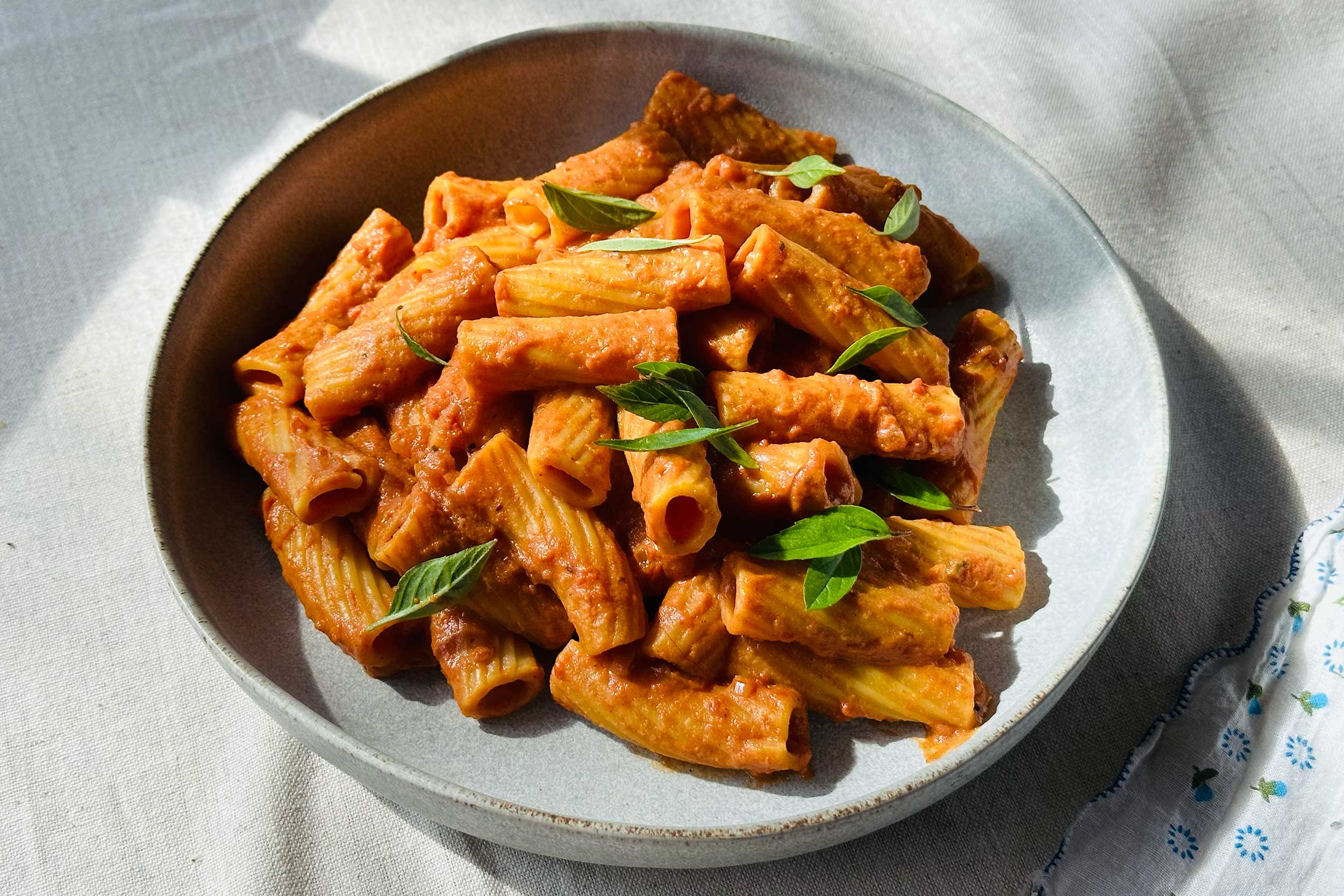Hey there, and welcome back to Cool Beans! Today in our venture through the basics of delicious, Earth-friendly eating we’re getting into the “meat” of the matter. It’s time for tofu. As a complete, cheap, and neutral protein, this soy-based ingredient is a plant-based staple. But it’s also kinda divisive. Some folks are turned off by tofu’s taste or texture. While there are several techniques for maximizing the flavor and feel of your ’fu, there’s actually a much easier route to embracing the soy protein. Instead of using it to replace meat, use it to replace dairy.
Tofu is made from soybean milk that’s boiled and curdled in a process that resembles cheesemaking. The image that likely jumps to mind when you think “tofu” is block tofu, which presses those curdles into soft, medium-firm, and firm varieties. In Western recipes, it’s typically used as a substitute for meat, à la the tofu nugget. Today, though, we’re talking about silken tofu, which is not pressed and therefore has a much higher moisture content, a silky smooth appearance, and a custardlike consistency that lends itself to dishes where creaminess is the goal, from smoothies and sauces to dips and desserts. It’s a nutritious workhorse that requires basically zero prep, comes in many shelf-stable varieties, and deffo deserves a spot in your pantry.
The review: A chocolate pudding free of dairy but full of surprises
Tofu puddings, made with custardy soft tofu, are a common street food in China and Southeast Asia where they are often topped with a ladle of warm ginger syrup. If eating straight soy is not your thing, you can still use it to make creamy and luxurious desserts without the use of dairy products. The proof is in the pudding, specifically this chocolate pudding with cinnamon and chile from Mark Bittman at The New York Times.
I’m not exaggerating when I say this dessert (snack? breakfast?) takes only 10 minutes to make. The only real “work”—if you can call it that—is making a quick simple syrup from sugar and water and melting chocolate in the microwave. The rest happens in a blender: Add silken tofu, melted dark chocolate, vanilla, cinnamon, and chile powder; blitz until smooth. The 30 minutes I had to wait while it chilled in the fridge was probably the hardest part.
A traditional pudding is a cooked, custardy mixture of milk or cream, sugar, and some starch to thicken the mix. I’ll admit that I had some serious doubts this tofu version—which was very thin at room temp—would set up the same way without any thickeners, dairy fat, or a leg up from a stand mixer. I was wrong: The texture set into a velvety smooth pudding, with a rich and chocolatey flavor that has a little kick from the spices.
Silken tofu has earned a place on my baking shelf, but its utility goes well beyond dessert. You can also use it instead of block tofu to make silky scrambles, creamy smoothies, and dairy/mayo-free sauces. To really test the limits of this soy protein, I decided to use it as a 1:1 replacement for the dairy in one of my all-time favorite cream-based pasta sauces.
The recipe: Creamy pasta sauce, hold the cream
I don’t buy heavy cream much, but if you see it in my fridge it’s because I’m making a pasta sauce like penne alla vodka. A lot of dairy-free versions of these luxe carb mainstays use alts like coconut milk and cashew cream, but I’ve never found one that doesn’t alter the flavor more than I’d like it to. Silken tofu, however, delivers a ridiculous level of creaminess, with zero effect on the overall flavor.
Take this plant-based version of vodka sauce, which is typically made with a healthy dose of heavy cream. My version replaces the dairy with silken tofu, but tastes just as rich as the real deal. In place of Parmesan, I added miso paste for an umami boost and some nutritional yeast for added “cheesy” flavor

Miso-Vodka Pasta
Yield: 4 servings
The content below was originally paywalled.
Ingredients:
2 tablespoons extra-virgin olive oil
1 medium yellow onion, finely chopped
4 garlic cloves, smashed
¾ teaspoon kosher salt, plus more for pasta water
1 6-ounce can tomato paste
1 28-ounce can crushed tomatoes
½ teaspoon red pepper flakes
16 ounces silken tofu
½ cup nutritional yeast or plant-based Parmesan
2 ounces (¼ cup) vodka
2 tablespoons white miso paste
1 pound rigatoni (or desired pasta shape)
Fresh basil leaves, torn, for serving
Procedure:
In a Dutch oven or large pot, heat the olive oil over medium heat. Add the onion, garlic, and ¼ teaspoon salt and cook, stirring occasionally, until the onion starts to brown around the edges, 5 to 7 minutes. Add the tomato paste and cook, stirring often, until the paste starts to darken, about 5 minutes. Add the tomatoes, red pepper flakes, and ½ teaspoon salt. Bring the mixture to a boil, then lower the heat and simmer while you prepare the next step.
While the sauce simmers, add the tofu, nutritional yeast, vodka, and miso paste to a blender and purée until smooth.
Add the tofu mixture to the pot and continue simmering for 20 minutes to develop the flavors and cook off the alcohol.
Meanwhile, bring a pot of salted water to a boil. Cook pasta according to the package directions until al dente. Drain the pasta, reserving 1 cup of the starchy pasta water. Add the noodles to the sauce. Add the reserved pasta water, if necessary, until the sauce is smooth and glossy enough to coat the noodles. Divide into four bowls and garnish with basil.
Notes and Substitutions:
Silken tofu is usually sold in plastic tubs next to the refrigerated block tofu, or in shelf-stable cardboard boxes. I prefer the former if I’m eating silken tofu on its own with toppings, but the shelf-stable stuff is perfect for keeping on hand for weeknight pastas and morning smoothies. It doesn’t need to be drained or pressed, so just throw it right into the skillet or blender.
For salting pasta water, use 1 ½ tablespoons of kosher salt for every 4 quarts of water.

